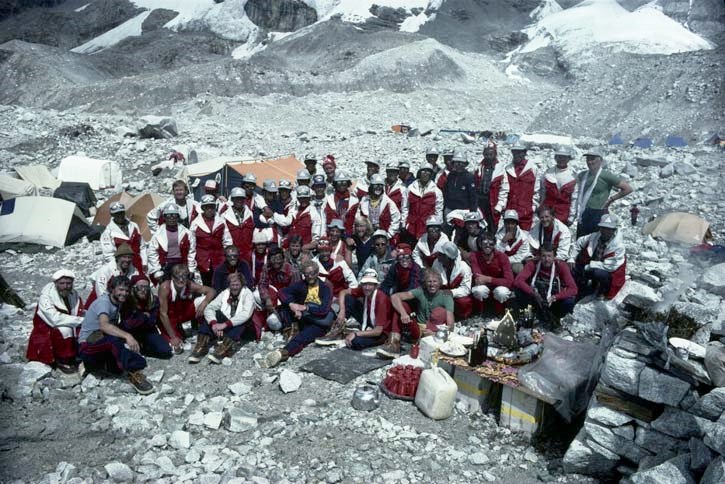It was a first for Canada, and it was among the last of its kind.
The 1982 Canadian Mount Everest expedition succeeded in placing the first two Canadians on the world’s highest summit, when Laurie Skreslet reached the top on Oct. 5 with Lhakpa Dorje and Sungdare Sherpa and Pat Morrow summited two days later with Pema Dorje and Lhakpa Tshering.
It was also an expedition filled with heartbreak, as Sherpa team members Ang Chuldim, Pasang Sona and Dawa Dorje were killed in an avalanche, and Canadian cameraman Blair Griffiths died in a serac collapse in the Khumbu Icefall.
The large-scale enterprise was among the last of heavily-sponsored expeditions climbing the mountain in the name of national achievement. But those are just some of the reasons the Banff Centre’s Paul D. Fleck Library and Archives has created the 1982 Everest Expedition Collection.
“The 1982 Everest expedition was historically significant not only because it put the first two Canadians on the summit of Mount Everest, but also because it was one of the last expeditions of its kind – a national expedition to climb Everest, done for national pride,” said Banff Centre archivist John Yolkowski. “Nowadays, the majority of climbers are individuals and privately guided clients.”
The 1982 team included 15 Canadian climbers, five support staff and 29 high-altitude Sherpas to help ferry all their necessary equipment up the mountain to establish a series of high camps. The expedition’s primary sponsor was Air Canada – one of more than 100 sponsors – and the climbers represented a diverse group of Canada’s most skilled and experienced mountaineers, several of whom still live in Banff, Canmore and Calgary area. After the two fatal accidents, seven team members chose to return to Canada, while the remainder stayed to ensure, among other reasons, their comrades’ deaths were
not in vain.
“We had the cream of Canadian climbers on the team,” Morrow said. “Then we were hit by a major avalanche and an icefall collapse and that turned the tide of the momentum of the whole team. Our objective was completely changed by the accidents that happened. The people who stayed learned how to change gears and change objectives.”
They completed their goal without further setbacks, and with tremendous pride.
“Taking on such a large mountain – we had to get through an icefall that you wouldn’t even attempt on any other mountain,” Morrow said. “Even if you’re the only one who gets to the top, there’s a huge effort of others who helped you get there.”
The expedition also accomplished another first, said Canmore resident John Amatt who served as the expedition’s media manager.
“The 1982 Canadian Mount Everest Expedition, Sponsored by Air Canada – that was the official name of the endeavour – was a significant achievement for Canada in that it not only put two Canadians on top of the world for the first time, but also, for the first time, was able to broadcast ‘live’ television from the mountain,” Amatt said.
“Previous expeditions had filmed on the mountain, but the finished products had not been available to the public until months afterwards. Live news reports were carried for over a month on CBC-TV’s program, The Journal with Barbara Frum, but also on ABC’s Nightline program with Ted Kopple. This was an important technological ‘first’ for Canada and needed to be archived correctly, which the Banff Centre was able to provide.”
With a strong connection to the Banff Centre, where he worked for several years, and having launched the Banff Mountain Film Festival in 1976, Amatt was instrumental in contributing to
the project.
The collection began with Jim Muir, head of a Montreal-based firm tasked with managing the team’s photographs and creating presentation materials, who donated the materials to the Banff Centre’s Mountain Culture Department in the 1990s. Amatt provided other materials, including audio recordings. Then last year, Banff Centre Archives practicum Abigail Sebaly was able to process, digitize and describe the material to make it available to researchers and the general public.
In addition, Sebaly initiated an oral history project, recording interviews with a dozen original team members.
“From the Banff Centre Archives’ point of view, we really wanted to be able to tell this important story, and make sure that these documents were preserved for future generations,” Yolkowski said.
With a considerable amount of raw film footage to work with, including original base camp radio transmissions, the Banff Centre Archives hosted a public presentation during the Banff Centre Mountain Film Festival in November.
The collection housed at the Banff Centre’s Paul D. Fleck Library includes about 2,000 photographs and slides from the expedition, hours of original film footage and more than 100 audio recordings.
“The collection also includes some physical material, including textual documents – newspaper coverage, promotional material created for the expedition, and even lists of supplies taken by the climbers – so you can see how many Oreos they ate and how much Scotch they drank,” Yolkowski said.
The collection is open to the public at the Paul D. Fleck Library at the Banff Centre Monday to Friday, 9 a.m. to 5 p.m., or by appointment. Visit www.banffcentre.ca/articles/everest-archives for more information.




